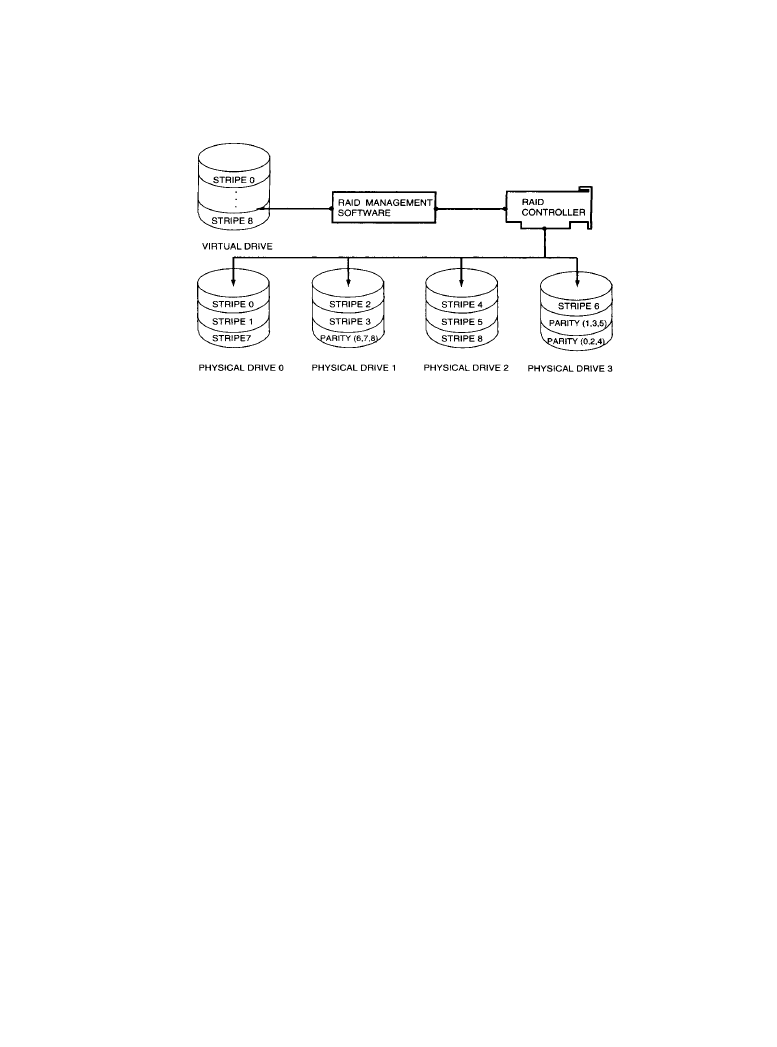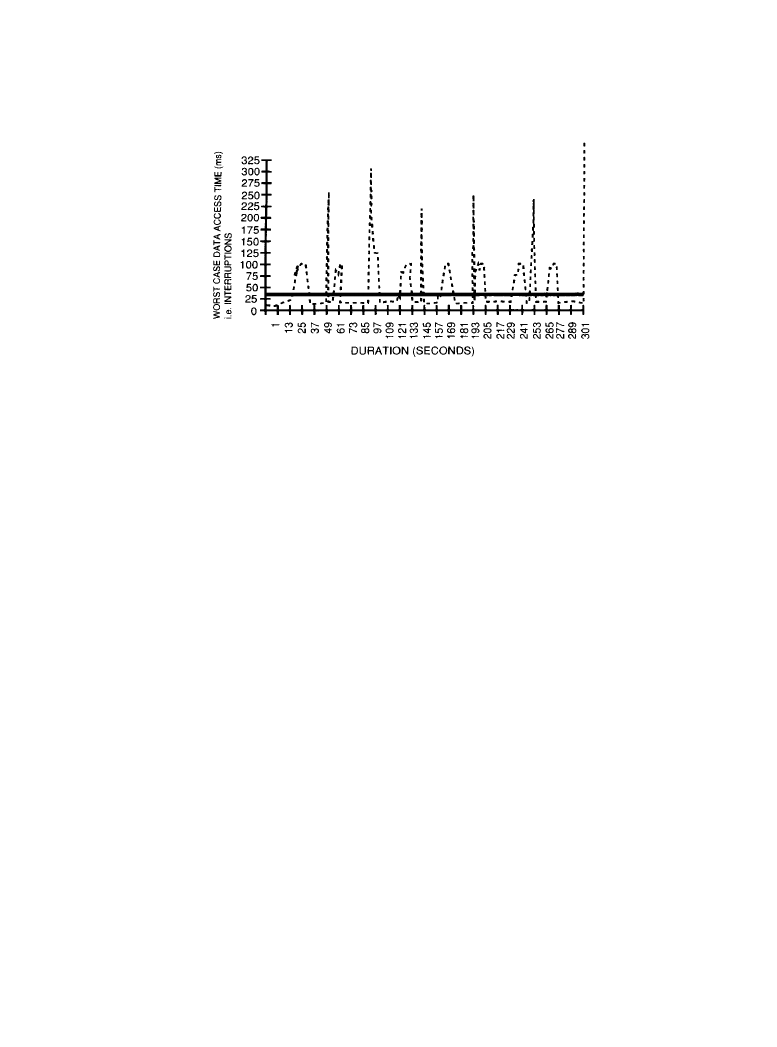ВУЗ: Казахская Национальная Академия Искусств им. Т. Жургенова
Категория: Книга
Дисциплина: Не указана
Добавлен: 03.02.2019
Просмотров: 21722
Скачиваний: 19

Audio/Video Server Systems 9-17
•
RAID Level 6, which emphasizes ultra-high data integrity
•
RAID Level 10, which focuses on high I/O performance and very high data integrity
•
RAID Level 53, which combines RAID Level 0 and 3 for uniform read and write perfor-
mance
Perhaps the greatest advantage of RAID technology is the sheer number of possible adaptations
available to users and systems designers. RAID offers the ability to customize an array sub-
system to the requirements of its environment and the applications demanded of it. These
attributes make RAID systems an integral element in applications requiring mass storage of
audio and video signals, such as servers. Table 9.1.4 lists the relative attributes of the various
RAID implementations.
9.1.4
Digital Media Applications
Speed and storage capacity are particularly important to digital media applications (those appli-
cations that record or play audio and/or video data) [3,4]. One minute of uncompressed CD-qual-
ity audio requires over 4.5 megabytes of storage. That is over 150 times the storage required to
hold most word processing documents. The typical data rate requirement for a single channel of
uncompressed digitally encoded audio is 76 KB/s.
For digital video, the capacity requirements jump exponentially. A single frame of 70 mm
film, if stored in uncompressed format, requires 40 MB of disk storage. Video is typically com-
pressed to increase the amount of information that can be stored on the disk and to reduce the
high data rate requirements. The data rate varies depending upon the video compression tech-
niques used (JPEG, MPEG, or other proprietary schemes) and the desired quality of the stored
Figure 9.1.9
RAID Level 5 overcomes the RAID Level 4 write bottleneck by distributing parity
stripes over two or more drives within the system. This better allocates write activity over the RAID
drive members, thus enhancing system performance. (
From [3]. Used with permission.)
Audio/Video Server Systems
Downloaded from Digital Engineering Library @ McGraw-Hill (www.digitalengineeringlibrary.com)
Copyright © 2004 The McGraw-Hill Companies. All rights reserved.
Any use is subject to the Terms of Use as given at the website.

9-18 Audio Recording Systems
video image. One minute of broadcast-quality video using JPEG compression requires at least
120 MB of storage. The data rate can vary from 150 KB/s of video for MPEG compression, up to
27 MB/s for full frame, uncompressed, interlaced video.
Simply put, the higher the video resolution the more space and higher data rate it requires.
Where a 4 GB capacity drive might have been big enough for a mid-quality video production,
higher quality video may require 9 GB of storage for a given segment.
Storing audio and video information on disk drives is a logical step on the digital media road
because it provides instant access to stored data. However, not all disk storage is created equal.
Optimizing disk drives for digital media requires more than just high capacity and fast data rates.
Data processing applications read and write small chunks of data stored more or less randomly
around the disk. Consequently, conventional disk drives have been optimized for small block,
random data transfers. Yet, while contemporary data processing disk drives deliver data to tradi-
tional applications quickly, they may have difficulties satisfying the requirements for real-time
audio and video applications. Because of the nature of audio and video playback, digital media
applications require that data be delivered on time, at the required rate, with no delay. Any delay
in the delivery of data from the disk will cause noticeable interruption in the playback, resulting
in audio breaks and/or missing video frames.
The linear nature of sound and video playback dictates that these files must be organized con-
tiguously on the disk in much the same way as they are on tape. With tape, the media containing
the information travels past the read head at the velocity required to present the sound and
images at a real-time speed. In this case, the next word, musical note, or video frame always
resides adjacent to the current sound or picture. It is the sequential linearity of tape that ideally
suits it for these purely “playback” applications. When the application demands manipulation or
editing of the audio or video information, the utility of linear tape storage methods quickly
become dubious and cumbersome.
For video servers and non-linear audio and video production systems, a storage device is
required that can instantly access any video frame, sound, or word, and record or play back with
the same or better measured precision as tape. This is a type of storage for which standard data
processing disk drives were not designed. Figure 9.1.10 charts the speed and smoothness of a
disk’s throughput by graphing worst-case data access over time. The performance of the tested
Table 9.1.4 Summary of RAID Level Properties
(
After [3].)
RAID Level
Capacity
Data Availability
Data Throughput
Data Integrity
0
High
Read/Write High
High I/O Transfer Rate
1
Read/Write High
Mirrored
2
High
High I/O Transfer Rate
ECC
3
High
High I/O Transfer Rate
Parity
4
High
Read High
Parity
5
High
Read/Write High
Parity
6
Read/Write High
Double Parity
10
Read/Write High
High I/O Transfer Rate
Mirrored
53
High I/O Transfer Rate
Parity
Audio/Video Server Systems
Downloaded from Digital Engineering Library @ McGraw-Hill (www.digitalengineeringlibrary.com)
Copyright © 2004 The McGraw-Hill Companies. All rights reserved.
Any use is subject to the Terms of Use as given at the website.

Audio/Video Server Systems 9-19
drive is indicated by the broken line. The straight, solid line above the X axis indicates the slow-
est acceptable access time to deliver video data. Every time the disk drive data response time
exceeds this value, the video playback will experience dropouts or lost frames, which result in
visual and/or audible discontinuities in the playback.
Previously, data interruptions were solved by adding large memory buffers in the host system
to hold several frames of data while the disk performed the requisite housekeeping chores.
Although host memory buffers cannot be completely eliminated, their size and subsequent cost
can be significantly reduced by minimizing the time the disk spends attending to certain house-
keeping functions. A disk drive optimized for continuous recording and playback will maintain a
virtually constant data rate to ensure that every picture and every sound is recorded and played
back without any evident errors. The broken line in Figure 9.1.11 illustrates the performance of a
drive optimized for audio/video applications.
Different manufacturers approach the challenges of designing drives optimized for audio/
video applications in different ways. One design achieves the desired relatively flat data rate per-
formance by changing the way disk drives work. By designing disk storage with the require-
ments of digital media in mind—including the development of new on-disk caching schemes
optimized for the file characteristics of audio and video applications and the implementation of
“intelligent housekeeping” techniques to hide necessary tasks in the background—the overall
performance is improved considerably.
9.1.4a
Optimizing Digital Media Disk Performance
Although the error recovery methods used in conventional disk drives are adequate to keep disks
operating within desired parameters, they are not optimized for speed [3,4]. To maintain the disk
drive at its optimum operating range, or to correct errors, some additional issues are important.
Issues that can interrupt the flow of data include the following:
Figure 9.1.10
Disk drive data access as a function of play time for a conventional hard drive. Host
demand rate = 4.0 MB/s. (
From [3]. Used with permission.)
Audio/Video Server Systems
Downloaded from Digital Engineering Library @ McGraw-Hill (www.digitalengineeringlibrary.com)
Copyright © 2004 The McGraw-Hill Companies. All rights reserved.
Any use is subject to the Terms of Use as given at the website.

9-20 Audio Recording Systems
•
Error recovery procedure overhead. The error recovery procedure within most conven-
tional disk drives is very robust and thorough. However, it is a major contributor to data flow
interruptions due to “soft” data errors. For example, the time required for a worst case recov-
ery from a correctable data error can exceed 750 ms. Most digital media applications cannot
tolerate a delay of this magnitude without a disruption in the audio or video playback. One
solution to this situation is to implement sophisticated and exceptionally reliable means of
error correction that maintains data integrity while rapidly completing housekeeping and
recovery tasks. The time required to perform error recovery procedures can, in most cases, be
held to 10 ms or less.
•
Hardware ECC on the fly. By adding a dedicated hardware correction engine, hardware-
implemented error correcting code can be implemented “on the fly.” In other words, a soft
read error can—in most cases—be corrected by a dedicated hardware correction engine. This
operation is done literally “on the fly” within a few hundred microseconds, without incurring
the overhead of waiting a full rotation in order to read the same data again. The more conven-
tion approach uses a software error correcting code technique which is many times slower
than the hardware ECC approach.
•
Rotational retries. If hardware ECC is not present in the drive or is unsuccessful in properly
recovering the data, the next step in the error recovery process is to simply retry the operation.
This approach, however, is not optimized for speed. When a disk tries to re-read data it could
not retrieve on the first pass, at least one revolution is lost. The ECC on-the-fly techniques
described previously can usually recover soft read errors without extra disk revolutions.
•
Thermal calibration (T-Cal). Thermal calibration is a periodic (e.g., every 10 min) house-
keeping function that is necessary for disk drives incorporating a dedicated servo system.
Dedicated servo designs are commonly used by many disk drive manufacturers. The T-Cal
operation calibrates the servo system to ensure that the disk heads remain precisely over the
data tracks by compensating for temperature changes during normal operations. The T-Cal
operation, depending upon the exact design, can require hundreds of milliseconds to com-
plete. During all or at least part of this process, the drive will not be responsive to data
Figure 9.1.11
Disk drive data access as a function of play time for a hard drive optimized for A/V
applications. Host demand rate = 4.0 MB/s. (
From [3]. Used with permission.)
Audio/Video Server Systems
Downloaded from Digital Engineering Library @ McGraw-Hill (www.digitalengineeringlibrary.com)
Copyright © 2004 The McGraw-Hill Companies. All rights reserved.
Any use is subject to the Terms of Use as given at the website.

Audio/Video Server Systems 9-21
requests. Drives optimized for audio/video applications can employ a hybrid servo system,
which combines the best features of both dedicated and embedded servo system designs and
eliminates the requirement for periodic T-Cal operations. Through clever design, it is possible
to eliminate T-Cal operations, not simply defer them.
•
Data head degaussing. During the normal course of disk operation, the data heads accumu-
late a slight magnetic orientation. This residual magnetism can adversely affect operation. To
prevent this condition, the drive must degauss each head. Because head degaussing involves
at least one head seek plus some rotational latency, this activity can cost more than 40 ms and
will interrupt the flow of data from the disk. Refined degaussing schemes minimize head
seeking and rotational latency.
By combining the foregoing techniques, it is possible to significantly improve the overall sus-
tainable throughput of disk drives so that they can reliably be used for demanding audio/video
applications.
Thermal Calibration
It is worthwhile to explore the issue of T-Cal in greater detail. To understand the need for thermal
calibration, the physics of disk drives must be examined [5]. All metals expand and contract to a
certain degree under varying temperatures. The same is true with disk drive parts, including plat-
ters and the actuator arms that read the data. As a drive spins, the components heat up and
expand. Although the size variance may at first seem minimal, it is potentially rather significant
as tracks are spaced closer together on disk drives.
Initially, drives circumvented this problem by delaying read/write operations long enough to
re-calibrate the location of the actuator arm over the platter. This would take a few milliseconds,
and would be unnoticeable in standard applications. With A/V projects, however, a pause lasting
several milliseconds can result in skipped frames and lost audio output.
Several approaches have been developed to solve this problem. One involves the reposition-
ing of the heads. Normally, all heads of a disk drive would re-calibrate at the same time, bringing
a complete stop to the data flow. To minimize the duration of data flow interruptions, newer
drives reposition one head at a time. Further, the drive can complete a thermal calibration by tak-
ing advantage of its onboard cache. A segment of data is read ahead of time and stored in the
drive buffer. When that data is requested from the computer, the drive dumps it from the cache
back to the system. While the buffer is being read, the actuator arms take the opportunity to reca-
librate.
9.1.4b
SCSI and Fibre Channel
Although not specifically a function of disk drive technology, new variations of SCSI and Fibre
Channel Arbitrated-Loop (FC-AL) are important in the broad view of storage technology
because of their impact on data transfer rates [3]. For this reason, they will be examined briefly
here.
Since its inception in the early 1980s, SCSI has evolved to become a widely-accepted and
successful disk drive interface [6]. Despite its venerability, however, parallel SCSI still has its
drawbacks, including cable distance limitations, a confusing mix of variants to the bus (Fast,
Fast&Wide, Differential, Ultra, and so on) and a ceiling on the number of peripherals it can sup-
port. SCSI throughput performance has also reached a point where disk drive capacities and data
Audio/Video Server Systems
Downloaded from Digital Engineering Library @ McGraw-Hill (www.digitalengineeringlibrary.com)
Copyright © 2004 The McGraw-Hill Companies. All rights reserved.
Any use is subject to the Terms of Use as given at the website.